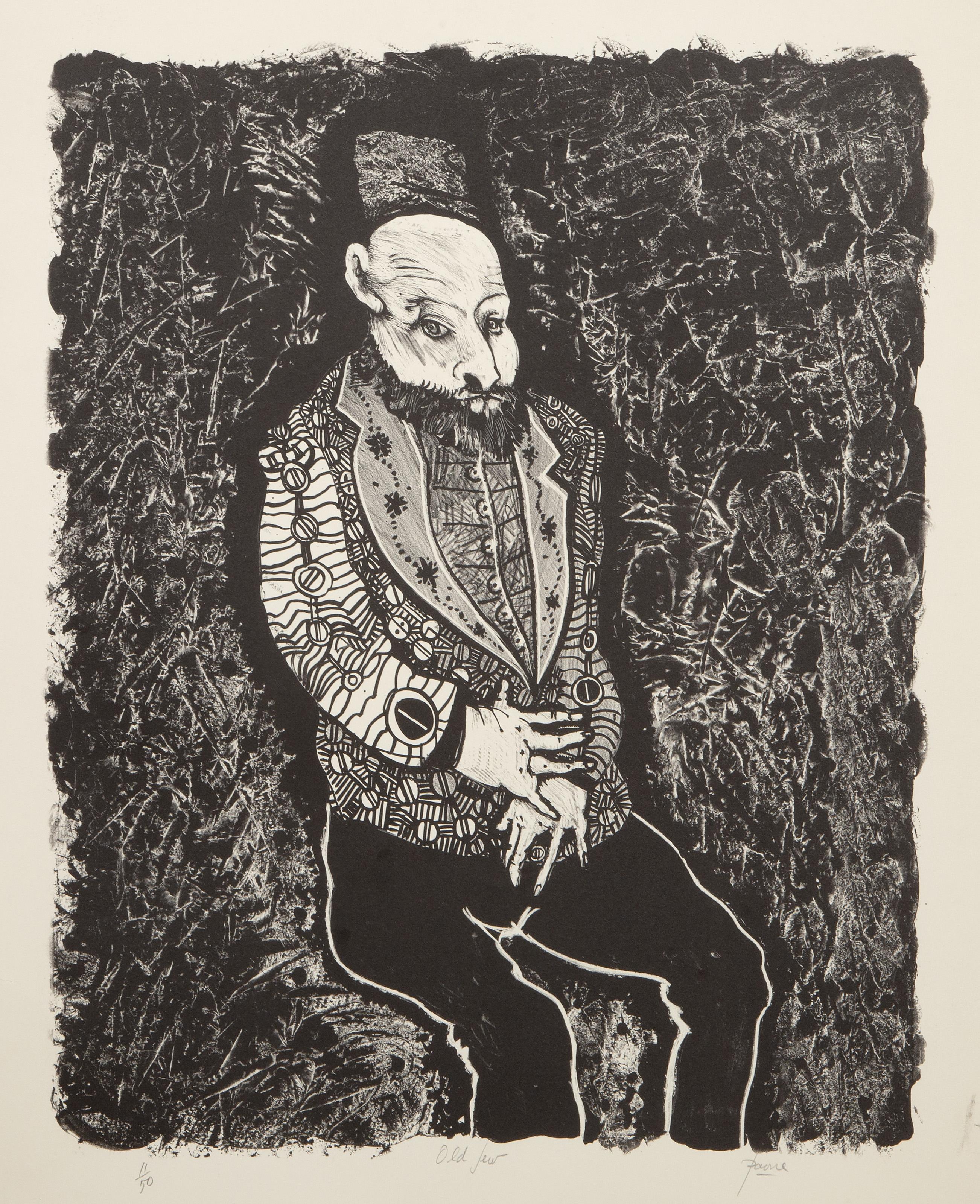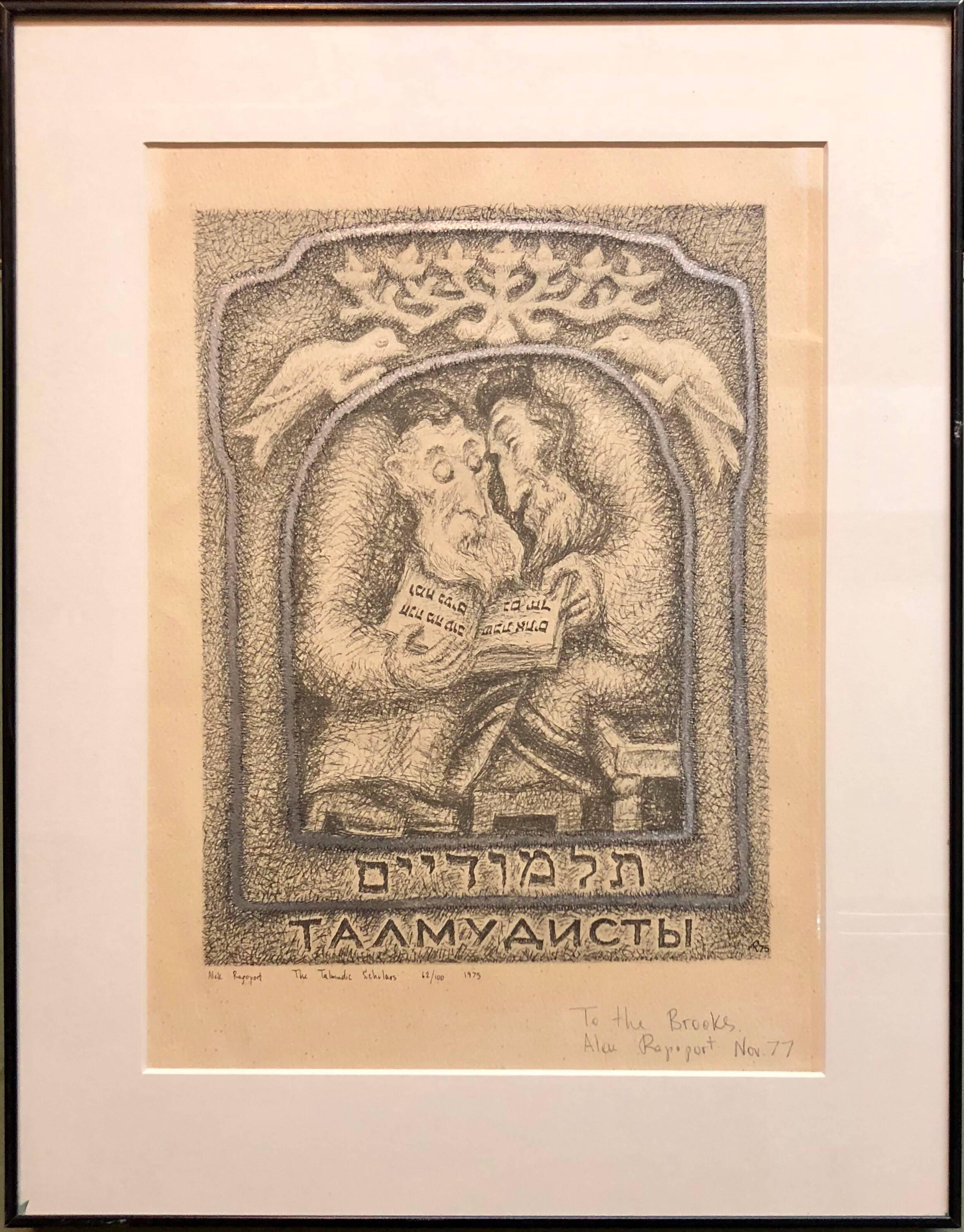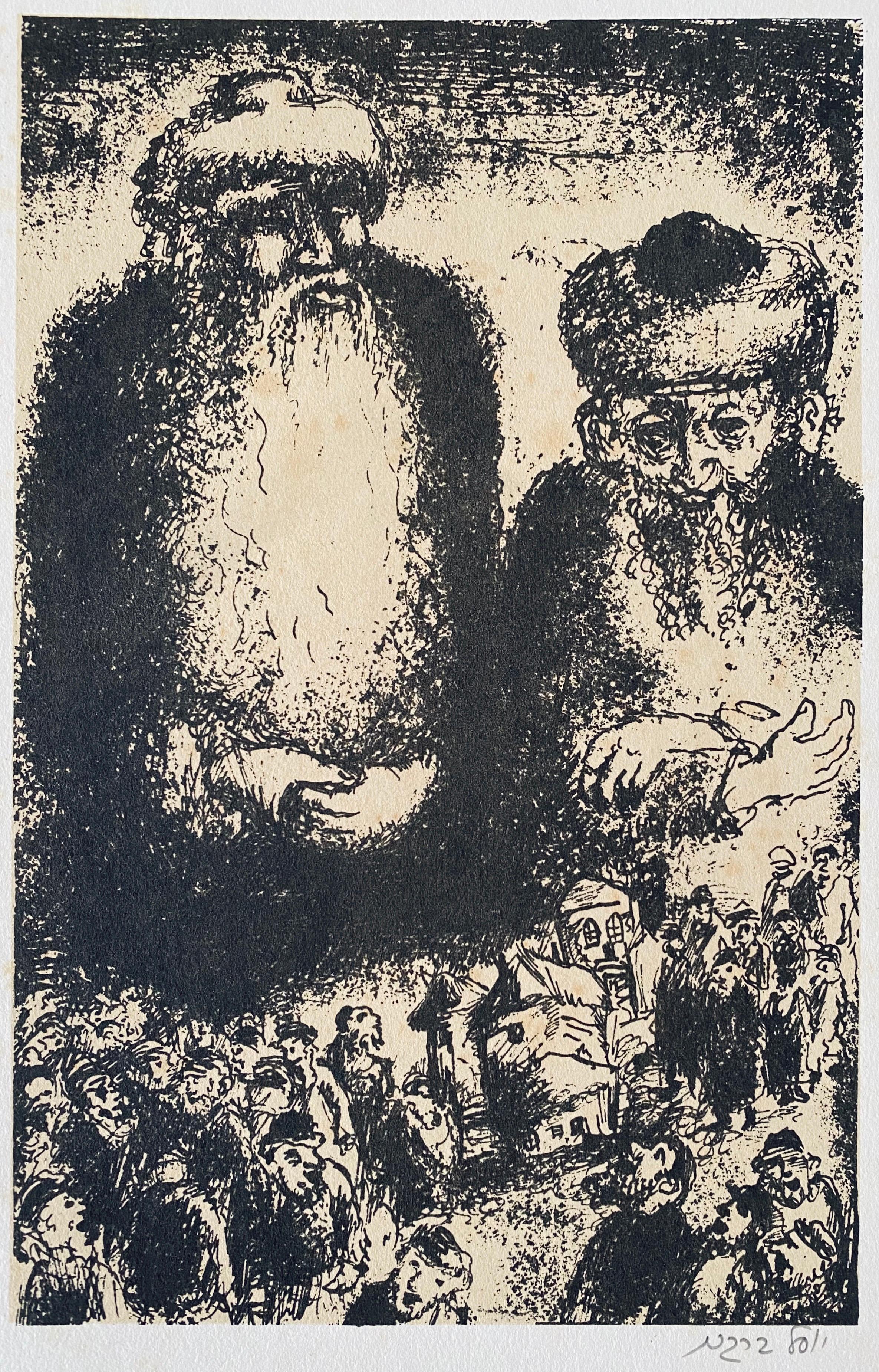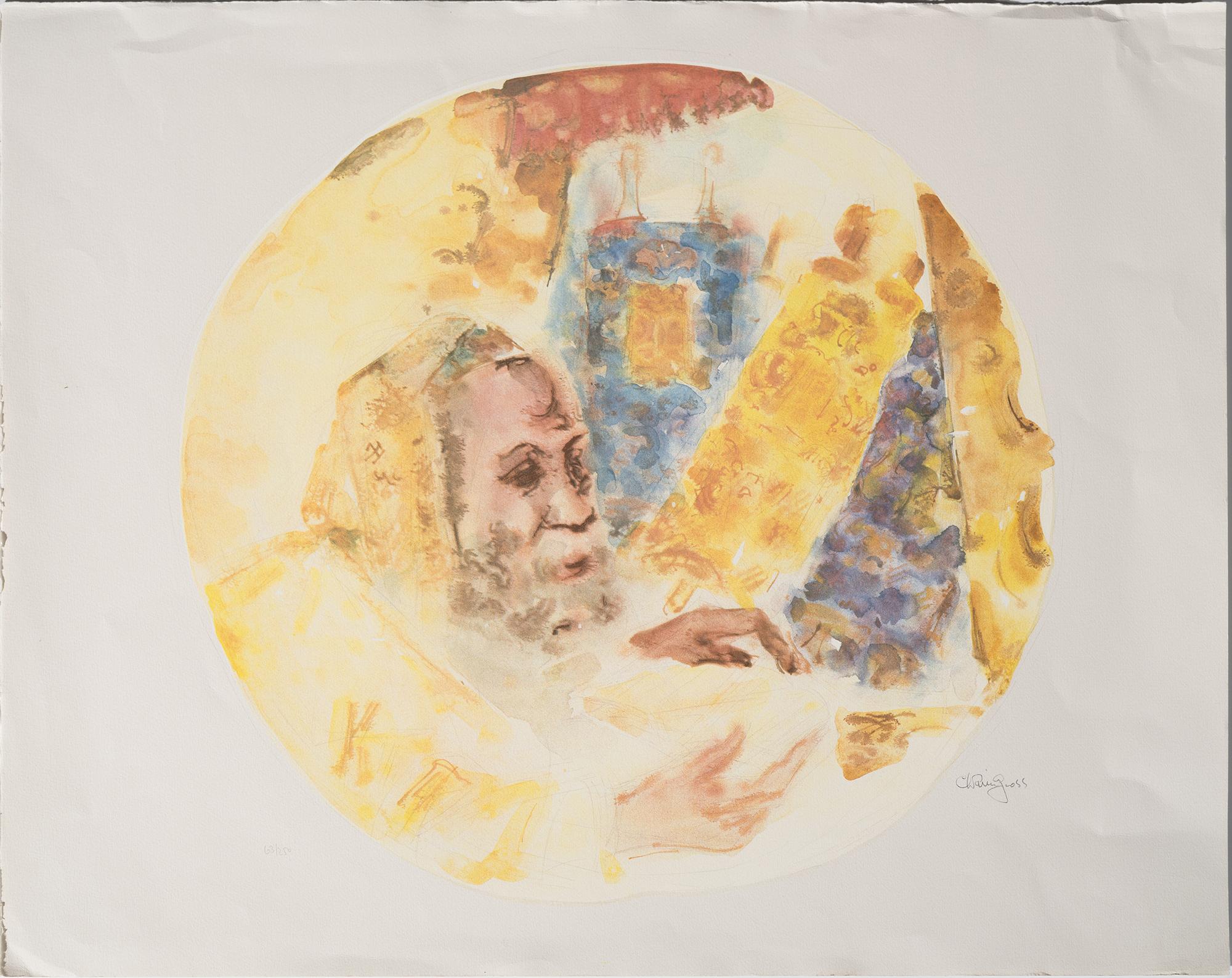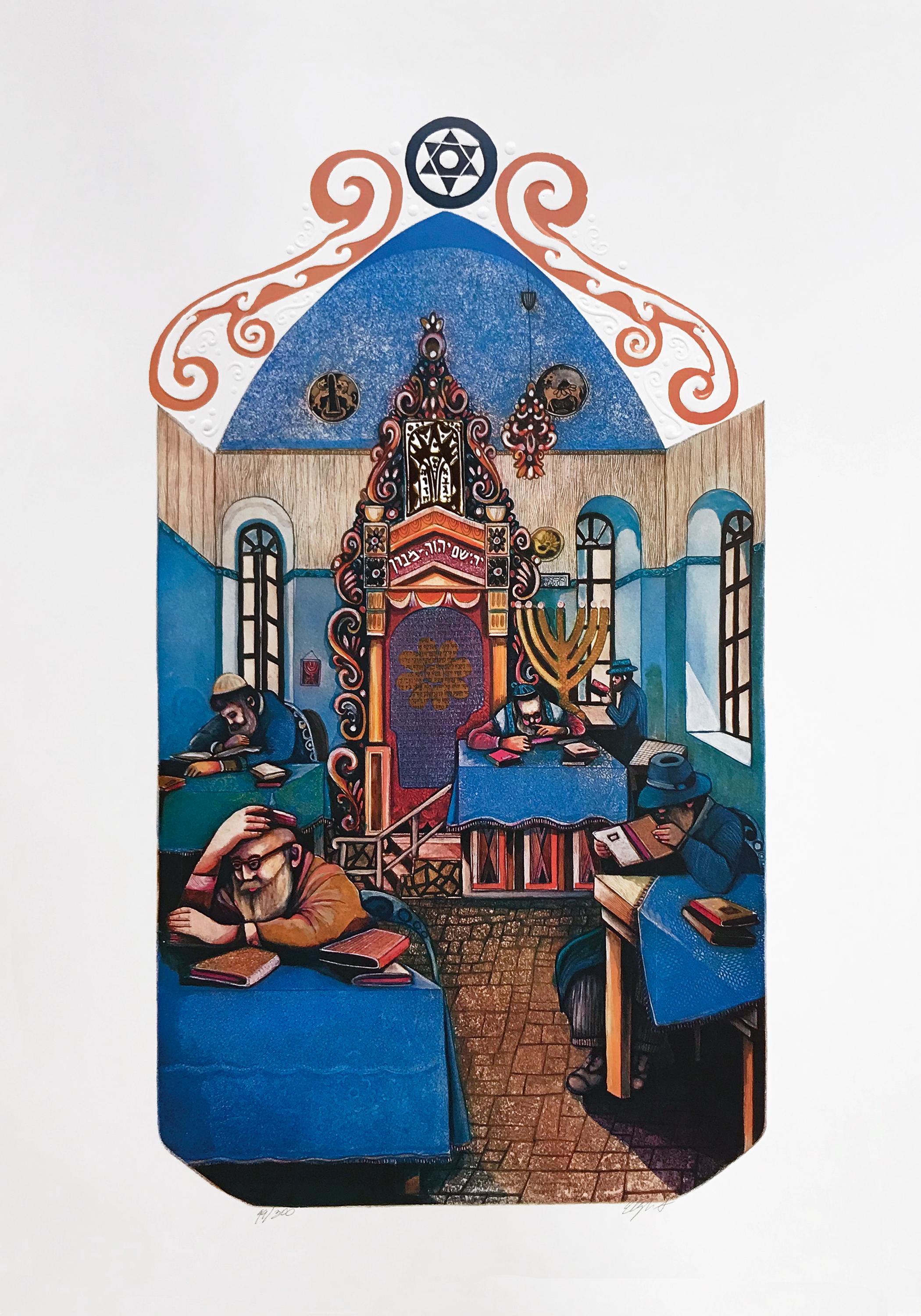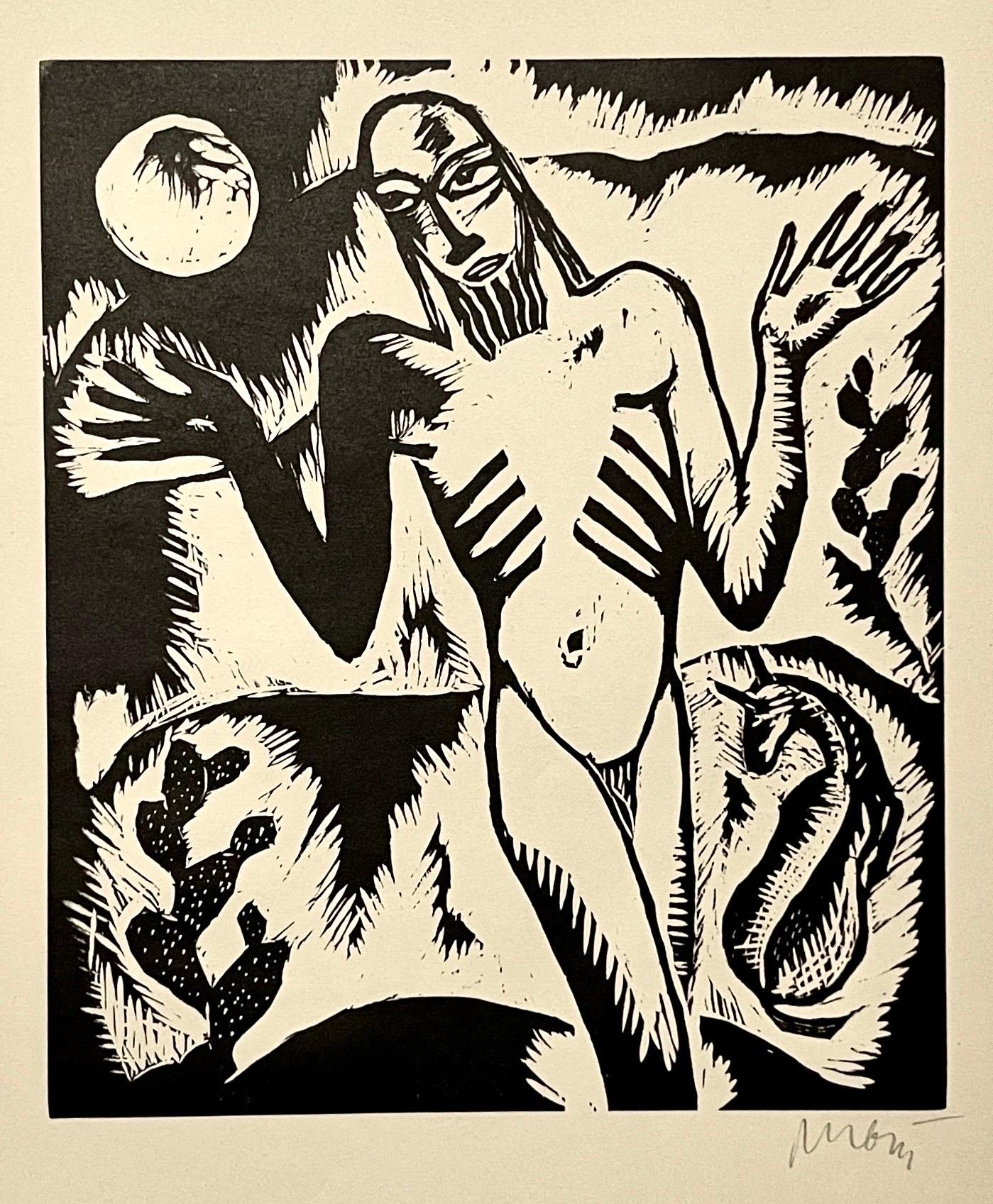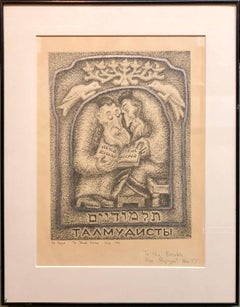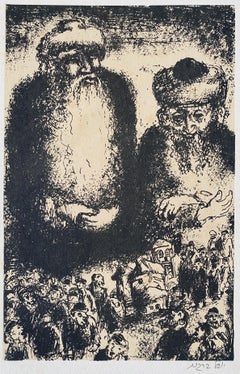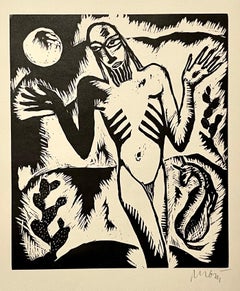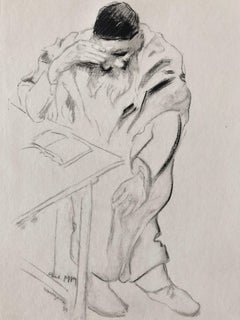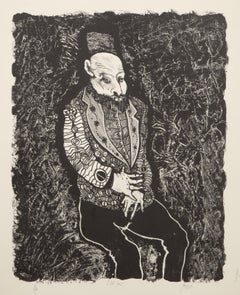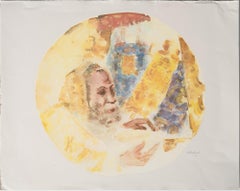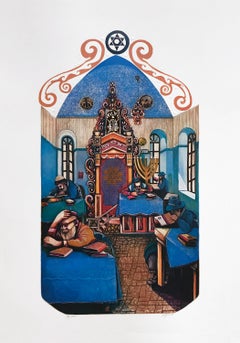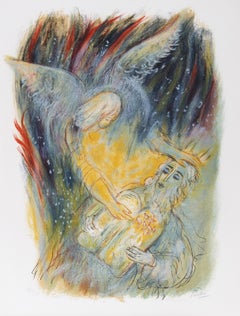Items Similar to The Rabbi 1977 Soviet Non Conformist Avant Garde Print
Want more images or videos?
Request additional images or videos from the seller
1 of 6
Alek RapoportThe Rabbi 1977 Soviet Non Conformist Avant Garde Print1977
1977
$1,250
£972
€1,105.18
CA$1,800.89
A$1,969.04
CHF 1,029.44
MX$23,687.26
NOK 13,026.50
SEK 12,217.71
DKK 8,252.27
About the Item
Dimensions w/Frame: 25 3/4" x 20 3/4"
Alek Rapoport (November 24, 1933, Kharkiv, Ukraine SSR – February 4, 1997, San Francisco) was a Russian Nonconformist artist, art theorist and teacher.
Alek Rapoport spent his childhood in Kiev (Ukraine SSR). During Stalin's "purges" both his parents were arrested. His father was shot and his mother spent ten years in a Siberian labor camp. Rapoport lived with his aunt. At the beginning of World War II, he was evacuated to the city of Ufa (the Bashkir Autonomous Soviet Socialist Republic). A time of extreme loneliness, cold, hunger and deprivation, this period also marked the beginning of Rapoport's drawing studies.
After the war, Rapoport lived in Chernovtsy (Western Ukraine), a city with a certain European flair. At the local House of Folk Arts, he found his first art teacher, E.Sagaidachny (1886–1961), a former member of the nonconformist artist groups Union of the Youth (Soyuz Molodyozhi) and Donkey's Tail, popular during the 1910s–1920s. His other art teacher was I. Beklemisheva (1903–1988). Impressed by Rapoport's talent, she later (1950) organized his move to Leningrad, where he entered the famous V.Serov School of Art (the former School of the Imperial Society for the Promotion of Arts, OPKh, later the Tavricheskaya Art School).
His association with this school lasted eight years, first as a student, and then, from 1965 to 1968, as a teacher. With "Socialist realism" the only official style during this time, most of the art school's faculty had to conceal any prior involvement in non-conformist art movements. Ya.K.Shablovsky, V.M.Sudakov, A.A.Gromov introduced their students to Constructivism only through clandestine means.
(1959–1963) Rapoport studied stage design at the Leningrad Institute of Theater, Music and Cinema under the supervision of the famous artist and stage director N.P.Akimov. Akimov taught a unique course based on theories of Russian Suprematism and Constructivism, while encouraging his graduate students to apply their knowledge to every field of art design. Despite differences in personal artistic taste with Akimov, who was drawn to Vermeer and Dalí, Rapoport was influenced by Akimov's personality and liberalism, as well as the logical style of his art.
In 1963, Rapoport graduated from the institute. His highly acclaimed MFA work involved the stage and costume design for I.Babel's play Sunset. In preparation, he traveled to the southwest regions of the Soviet Union, where he accumulated many objects of Judaic iconography from former ghettos, disappearing synagogues and old cemeteries. He wandered Odessa in search of Babel's characters and the atmosphere of his books.
He organized a new liberal course in technical aesthetics, introducing his students to Lotman's theory of semiotics, the Modulor of Le Corbusier, the Bauhaus school, Russian Constructivism, Russian icons and contemporary Western art. As a result of his "radicalism," Rapoport was fired for "ideological conspiracy."
He sought to cultivate himself as Jewish artist. This became particularly noticeable after the Six-Day War, when the Israeli victory led intellectuals, including the Jewish intelligentsia, to feel a heightened interest in Jewish culture and its Biblical roots. Rapoport's works of this period include Three Figures, a series of images of Talmudic Scholars, and works dealing with anti-Semitism. In the 1970s Rapoport joined the non-conformist movement, which opposed the dogmas of "Socialist realism" in art, along with Soviet censorship. The movement sought to preserve the traditions of Russian iconography and the Constructivist/Suprematist style of the 1910s. Despite the authorities' persecutions of nonconformist artists (including arrests, forced evictions, terminations of employment, and various forms of routine hassling), they united in a group, "TEV – Fellowship of Experimental Exhibitions." TEV's exhibitions proved tremendously successful.
In the same period, Rapoport became one of the initiators of another anti-establishment group, ALEF (Union of Leningrad's Jewish Artists). In the United States this group was known as "Twelve from the Soviet Underground." Rapoport's involvement with this group increased tension with the authorities and attracted KGB scrutiny, including "friendly conversations," surveillance, detentions and house arrests. It became increasingly dangerous for him to live and work in the USSR. In October 1976, Rapoport with his wife and son were forced to leave Russia.
In Italy, Rapoport exhibited at the Venice Biennale, "La Nuova Arte Sovietica-Una prospettiva non-ufficiale" (1977), participated in television programs about nonconformist art in the Soviet Union, and created lithographic works continuing his theme of Jewish characters from Babel's play Sunset.
In 1977, Rapoport's family was granted U.S. immigration status and settled in San Francisco. a significant event in Rapoport's life occurred in his meeting with San Francisco gallery owner Michael Dunev, who became his friend and representative, organizing all his exhibitions until the artist's death.
Toward the end of the 1980s and beginning of the 1990s, Rapoport completed his most ambitious works on the theme of the Old Testament prophets: Samson Destroying the House of the Philistines (1989), Lamentation and Mourning and Woe (1990), the four paintings Angel and Prophets (1990–1991) and Three Deeds of Moses (1992).
In 1992, the artist's friends in St. Petersburg organized the first exhibition of his works there since his departure into exile, with works patiently gathered from collectors and art museums. This exhibition, held in the City Museum of St. Petersburg and accompanied by headlines such as "A St. Petersburg artist returns to his town," was followed by much larger ones in 1993 (St. Petersburg and Moscow), organized in collaboration with Michael Dunev Gallery under the name California Branches – Russian Roots.
He Exhibited in "Soviet Artists, Jewish Themes," an exhibit of Nonconformist art of over 40 Jewish artists from the Soviet Union.
The variety of Jewish themes range from rural, village scenes to images of the Holocaust, to mystical interpretations based on Kabbalistic texts by artists such as Grisha Bruskin, Anatolii Kaplan, Vitaly Komar, Alexander Melamid, Leonid Lamm, Dmitrii Lion, and Alek Rapoport.
The exhibit focused on the work of Jewish artist in times of social oppression and were created in private, and were mostly kept hidden from the public eye.
Main personal exhibitions
1980 – Gallerie "Trifalco," Rome, Italy
1981 – Images of San Francisco, Eduard Nakhamkin Gallery, New York, NY.
1984 – Images of San Francisco, University of the Pacific Gallery, Stockton, CA.
1986 – Images of San Francisco, Michael Dunev Gallery, San Francisco, CA.
1988 – Ecumenical Works, Michael Dunev Gallery, San Francisco, CA.
1992 – Russia-USA, The Museum of the City of St. Petersburg, St. Petersburg, Russia.
1993 – California Branches-Russian Roots, Manege Exhibition Hall, St. Petersburg, Russia; National Exhibition Hall, Moscow, Russia.
1996 – Ecumenical Paintings, SOMAR Gallery, San Francisco, CA.
1997 – The Last Paintings: A Memorial Exhibition, Michael Dunev Gallery, San Francisco, CA; The Early Drawings. A Memorial Exhibition. George Krevsky Fine Art, San Francisco, CA; Sacred Inspiration: Icons by Alek Rapoport, The Marian Library, IMRI, Dayton University, Dayton, OH.[14]
1998 – Angel and Prophet, Center for Art and Religion, Washington, DC.
2004 – Images of San Francisco, Diaghilev Art Center, St. Petersburg, Russia.
2007 – Alek Rapoport: A Memorial Exhibition, Belcher Studios Gallery, San Francisco, CA.
- Creator:Alek Rapoport (1933, Russian)
- Creation Year:1977
- Dimensions:Height: 25.75 in (65.41 cm)Width: 20.75 in (52.71 cm)
- Medium:
- Movement & Style:
- Period:
- Condition:
- Gallery Location:Surfside, FL
- Reference Number:1stDibs: LU38211624392
About the Seller
4.9
Platinum Seller
Premium sellers with a 4.7+ rating and 24-hour response times
Established in 1995
1stDibs seller since 2014
1,826 sales on 1stDibs
Typical response time: 1 hour
- ShippingRetrieving quote...Shipping from: Surfside, FL
- Return Policy
Authenticity Guarantee
In the unlikely event there’s an issue with an item’s authenticity, contact us within 1 year for a full refund. DetailsMoney-Back Guarantee
If your item is not as described, is damaged in transit, or does not arrive, contact us within 7 days for a full refund. Details24-Hour Cancellation
You have a 24-hour grace period in which to reconsider your purchase, with no questions asked.Vetted Professional Sellers
Our world-class sellers must adhere to strict standards for service and quality, maintaining the integrity of our listings.Price-Match Guarantee
If you find that a seller listed the same item for a lower price elsewhere, we’ll match it.Trusted Global Delivery
Our best-in-class carrier network provides specialized shipping options worldwide, including custom delivery.More From This Seller
View AllThe Talmudists Post Soviet Non Conformist Avant Garde Judaica Lithograph
By Alek Rapoport
Located in Surfside, FL
Dimensions w/Frame: 18.5 X 14.5
Alek Rapoport (November 24, 1933, Kharkiv, Ukraine SSR – February 4, 1997, San Francisco) was a Russian Nonconformist artist, art theorist and teacher.
Alek Rapoport spent his childhood in Kiev (Ukraine SSR). During Stalin's "purges" both his parents were arrested. His father was shot and his mother spent ten years in a Siberian labor camp. Rapoport lived with his aunt. At the beginning of World War II, he was evacuated to the city of Ufa (the Bashkir Autonomous Soviet Socialist Republic). A time of extreme loneliness, cold, hunger and deprivation, this period also marked the beginning of Rapoport's drawing studies.
After the war, Rapoport lived in Chernovtsy (Western Ukraine), a city with a certain European flair. At the local House of Folk Arts, he found his first art teacher, E.Sagaidachny (1886–1961), a former member of the nonconformist artist groups Union of the Youth (Soyuz Molodyozhi) and Donkey's Tail, popular during the 1910s–1920s. His other art teacher was I. Beklemisheva (1903–1988). Impressed by Rapoport's talent, she later (1950) organized his move to Leningrad, where he entered the famous V.Serov School of Art (the former School of the Imperial Society for the Promotion of Arts, OPKh, later the Tavricheskaya Art School).
His association with this school lasted eight years, first as a student, and then, from 1965 to 1968, as a teacher. With "Socialist realism" the only official style during this time, most of the art school's faculty had to conceal any prior involvement in non-conformist art movements. Ya.K.Shablovsky, V.M.Sudakov, A.A.Gromov introduced their students to Constructivism only through clandestine means.
(1959–1963) Rapoport studied stage design at the Leningrad Institute of Theater, Music and Cinema under the supervision of the famous artist and stage director N.P.Akimov. Akimov taught a unique course based on theories of Russian Suprematism and Constructivism, while encouraging his graduate students to apply their knowledge to every field of art design. Despite differences in personal artistic taste with Akimov, who was drawn to Vermeer and Dalí, Rapoport was influenced by Akimov's personality and liberalism, as well as the logical style of his art.
In 1963, Rapoport graduated from the institute. His highly acclaimed MFA work involved the stage and costume design for I.Babel's play Sunset. In preparation, he traveled to the southwest regions of the Soviet Union, where he accumulated many objects of Judaic iconography from former ghettos, disappearing synagogues and old cemeteries. He wandered Odessa in search of Babel's characters and the atmosphere of his books.
He organized a new liberal course in technical aesthetics, introducing his students to Lotman's theory of semiotics, the Modulor of Le Corbusier, the Bauhaus school, Russian Constructivism, Russian icons and contemporary Western art. As a result of his "radicalism," Rapoport was fired for "ideological conspiracy."
He sought to cultivate himself as Jewish artist. This became particularly noticeable after the Six-Day War, when the Israeli victory led intellectuals, including the Jewish intelligentsia, to feel a heightened interest in Jewish culture and its Biblical roots. Rapoport's works of this period include Three Figures, a series of images of Talmudic Scholars, and works dealing with anti-Semitism. In the 1970s Rapoport joined the non-conformist movement, which opposed the dogmas of "Socialist realism" in art, along with Soviet censorship. The movement sought to preserve the traditions of Russian iconography...
Category
1970s Post-Modern Figurative Prints
Materials
Lithograph
Israeli Expressionist Yosl Bergner Modernist Lithograph
By Yosl Bergner
Located in Surfside, FL
Hand signed in Hebrew Lower right. Dimensions: H 19.5" x 13.5"
Bergner, Yosl (Vladimir Jossif) (b Vienna, 13 Oct 1920). surrealist, surrealism. belongs to the generation of people...
Category
Mid-20th Century Modern Figurative Prints
Materials
Lithograph
Rare 1923 Cubist Reuven Rubin Woodcut Woodblock Kabbalah Print Israeli Judaica
By Reuven Rubin
Located in Surfside, FL
This is from the original first edition 1923 printing. there was a much later edition done after these originals.
These are individually hand signed in pencil by artist as issued.
This listing is for the one print. the other documentation is included here for provenance and is not included in this listing.
The various images inspired by the Jewish Mysticism and rabbis and mystics of jerusalem and Kabbalah is holy, dramatic and optimistic Rubin succeeded to evoke the spirit of life in Israel in those early days.
They are done in a modern art style influenced by German Expressionism, particularly, Ernst Barlach, Ernst Ludwig Kirchner, and Franz Marc, as introduced to Israel by Jakob Steinhardt, Hermann Struck and Joseph Budko.
Reuven Rubin 1893 -1974 was a Romanian-born Israeli painter and Israel's first ambassador to Romania.
Rubin Zelicovich (later Reuven Rubin) was born in Galati to a poor Romanian Jewish Hasidic family. He was the eighth of 13 children. In 1912, he left for Ottoman-ruled Palestine to study art at Bezalel Academy of Art and Design in Jerusalem. Finding himself at odds with the artistic views of the Academy's teachers, he left for Paris, France, in 1913 to pursue his studies at the École Nationale Supérieure des Beaux-Arts. He was of the well known Jewish artists in Paris along with Marc Chagall and Chaim Soutine,
At the outbreak of World War I, he was returned to Romania, where he spent the war years.
In 1921, he traveled to the United States with his friend and fellow artist, Arthur Kolnik. In New York City, the two met artist Alfred Stieglitz, who was instrumental in organizing their first American show at the Anderson Gallery. Following the exhibition, in 1922, they both returned to Europe. In 1923, Rubin emigrated to Mandate Palestine.
Rubin met his wife, Esther, in 1928, aboard a passenger ship to Palestine on his return from a show in New York. She was a Bronx girl who had won a trip to Palestine in a Young Judaea competition. He died in 1974.
Part of the early generation of artists in Israel, Joseph Zaritsky, Arieh Lubin, Reuven Rubin, Sionah Tagger, Pinchas Litvinovsky, Mordecai Ardon, Yitzhak Katz, and Baruch Agadati; These painters depicted the country’s landscapes in the 1920s rebelled against the Bezalel school of Boris Schatz. They sought current styles in Europe that would help portray their own country’s landscape, in keeping with the spirit of the time. Rubin’s Cezannesque landscapes from the 1920s were defined by both a modern and a naive style, portraying the landscape and inhabitants of Israel in a sensitive fashion. His landscape paintings in particular paid special detail to a spiritual, translucent light. His early work bore the influences of Futurism, Vorticism, Cubism and Surrealism.
In Palestine, he became one of the founders of the new Eretz-Yisrael style. Recurring themes in his work were the bible, the prophet, the biblical landscape, folklore and folk art, people, including Yemenite, Hasidic Jews and Arabs. Many of his paintings are sun-bathed depictions of Jerusalem and the Galilee. Rubin might have been influenced by the work of Henri Rousseau whose naice style combined with Eastern nuances, as well as with the neo-Byzantine art to which Rubin had been exposed in his native Romania. In accordance with his integrative style, he signed his works with his first name in Hebrew and his surname in Roman letters.
In 1924, he was the first artist to hold a solo exhibition at the Tower of David, in Jerusalem (later exhibited in Tel Aviv at Gymnasia Herzliya). That year he was elected chairman of the Association of Painters and Sculptors of Palestine. From the 1930s onwards, Rubin designed backdrops for Habima Theater, the Ohel Theater and other theaters.
His biography, published in 1969, is titled My Life - My Art. He died in Tel Aviv in October 1974, after having bequeathed his home on 14 Bialik Street and a core collection of his paintings to the city of Tel Aviv. The Rubin Museum opened in 1983. The director and curator of the museum is his daughter-in-law, Carmela Rubin. Rubin's paintings are now increasingly sought after. At a Sotheby's auction in New York in 2007, his work accounted for six of the ten top lots. Along with Yaacov Agam and Menashe Kadishman he is among Israel's best known artists internationally. Education
1912 Bezalel Academy of Arts and Design, Jerusalem
1913-14 École des Beaux Arts, Paris and Académie Colarossi, Paris
Select Group Exhibitions
Eged - Palestine Painters Group Eged - Palestine Painters Group, Allenby Street, Tel Aviv 1929
Artists: Chana Orloff, Abraham Melnikoff, Rubin, Reuven Nahum Gutman, Sionah Tagger,Arieh Allweil,
Jewish Artists Association, Levant Fair, Tel Aviv, 1929
Artists: Ludwig Blum,Eliyahu Sigad, Shmuel Ovadyahu, Itzhak Frenel Frenkel,Ozer Shabat, Menahem Shemi...
Category
1920s Abstract Figurative Prints
Materials
Woodcut
Judaica Jewish Shtetl Etching Hasidic Rabbi "Difficult Problem" Chassidic Print
By Paul Jeffay
Located in Surfside, FL
"Probleme ardu."
Chassidic boy, Yeshiva student with open book. Judaica, Jewish scenes from a ghetto.
Saul Yaffie, a.k.a. Paul Jeffay, (1898–1957) was a Scottish Jewish artist. Know...
Category
20th Century Expressionist Figurative Prints
Materials
Etching
Judaica Jewish Shtetl Etching Hasidic Rabbi, Meditation Vintage Chassidic Print
By Paul Jeffay
Located in Surfside, FL
"Le ciel est ouvert"
Older Chassidic rabbi learning with open book, Judaica, Jewish scenes from a ghetto.
Saul Yaffie, a.k.a. Paul Jeffay, (1898–1957) was a Scottish Jewish artist...
Category
20th Century Expressionist Figurative Prints
Materials
Etching
Hungarian Modernist Judaica Etching Print Teffilin, Jewish Rabbi in Prayer
By Janos Kass
Located in Surfside, FL
From very small edition of 15 on handmade mould made paper, with Jewish star Magen David watermark. From the deluxe boxed portfolio edition. Hand signed in pencil.
János Kass (December 26, 1927 – March 29, 2010) was a Hungarian illustrator, printmaker, graphic designer, postage stamp designer, animated film director and teacher. Hungary's foremost graphic artist and book illustrator. Born in Szeged, he was the storyboard artist for the first fully digital animated film. This is done in a manner reminiscent of Saul Raskin, Tully Filmus and William Gropper, this is a modern take on a classic judaic subject matter, similar in style and tone to Abram Krol, Jakob Steinhardt, Josef Budko and Hermann Struck.
Beginning his artistic studies at the Applied Art Academy, Kass finished in 1951 at the Academy of Fine Arts, a student of Gyula Hincz, György Kádár and György Konecsni. From 1956 to 1959 he held the Derkovits scholarship.
From 1961 to 1962, he was assistant professor at the Book-Art Academy in Leipzig, Germany.
Kass regularly took part in every major national exhibition at home and abroad. He had one-man shows in Italy (1963), Australia (1970) and Switzerland (1976). He participated in the Venice Biennial (1960), the Youth Biennial in Paris (1961), and Biennials in Lugano, Tokyo, Ljubljana, São Paulo and Buenos Aires, along with "Intergrafik" exhibitions in Berlin.
He made many friends within the British graphic art fraternity while spending some months in London during 1980, working on one of the earliest, fully digitized computer-animated films, Dilemma, with John Halas. He had already won recognition with his illustrations and book designs. At the 1973 Leipzig book fair, his work was awarded the title of best illustrated book at the fair. This accolade was repeated at the Frankfurt fair in 1999.
The 11-minute Dilemma was nominated at that year's Cannes Film Festival for the Golden Palm for Best Short Film, and is considered the first fully digital animated film. Kass was also a background artist for the "So Beautiful and So Dangerous" segment of Ivan Reitman Productions' 1981 animated feature film Heavy Metal.
Kass' drawings, etchings and silk-screen prints were exhibited in the Fitzwilliam Museum in Cambridge in 1989 and in 1990 at London Olympia. He later held a one-man show in Edinburgh.
He illustrated something like 400 books, classical novels and children's stories, among them an elegant edition of Imre Madách's 19th-century drama The Tragedy of Man, published in Iain MacLeod's translation by Edinburgh's Canongate press in 1993. He won Hungary's highest artistic award, the Kossuth prize, and was an elected member of the Széchenyi academy. János Kass’ s numerous works can be found in the Hungarian National Gallery. Since 1985, the János Kass Gallery...
Category
1990s Expressionist Figurative Prints
Materials
Etching
You May Also Like
Old Jew, Surrealist Lithograph by Peter Paone
Located in Long Island City, NY
Peter Paone, American (1936 - ) - Old Jew, Year: circa 1963, Medium: Lithograph on Rives, signed, titled and numbered in pencil, Edition: 11/50, Image Si...
Category
1960s Surrealist Portrait Prints
Materials
Lithograph
"The Rabbi and the Torah" unframed lithograph hand-signed by artist Chaim Gross
By Chaim Gross
Located in Boca Raton, FL
"The Rabbi and the Torah" unframed lithograph on fine art paper by artist Chaim Gross from a limited edition of 250. Hand signed Chaim Gross and hand numbered 63/250. Image size: 21...
Category
20th Century Modern Portrait Prints
Materials
Lithograph
YASHIVA IN JERUSALEM (JUDAICA ART)
By Amram Ebgi
Located in Aventura, FL
Embossed lithograph with foil stamping on paper. Hand signed and numbered by the artist. From the edition of 300.
Artwork is in excellent condition. Certificate of authenticity in...
Category
Late 20th Century Contemporary Figurative Prints
Materials
Foil
$100 Sale Price
50% Off
VII from Visions of the Bible, Modern Lithograph by Reuven Rubin
By Reuven Rubin
Located in Long Island City, NY
Reuven Rubin, Israeli (1893 - 1974) - VII from Visions of the Bible, Year: 1972, Medium: Lithograph, signed and numbered in pencil, Edition: 83/150, Image Size: 25 x 18 inches, S...
Category
1970s Modern Figurative Prints
Materials
Lithograph
Rabbi with Book - I, Folk Art Ink on Paper by Ira Moskowitz
By Ira Moskowitz
Located in Long Island City, NY
Ira Moskowitz, Polish/American (1912 - 2001) - Rabbi with Book - I, Year: circa 1989, Medium: Ink on Paper, signed, Size: 13 in. x 10 in. (33.02 cm x 25.4 cm), Description: Placing ...
Category
1980s Folk Art Portrait Drawings and Watercolors
Materials
Ink
X from Visions of the Bible, Modern Lithograph by Reuven Rubin
By Reuven Rubin
Located in Long Island City, NY
Reuven Rubin, Israeli (1893 - 1974) - X from Visions of the Bible, Year: 1972, Medium: Lithograph, signed and numbered in pencil, Edition: 83/150, Image Size: 25 x 18 inches, Siz...
Category
1970s Modern Figurative Prints
Materials
Lithograph
More Ways To Browse
Le Modulor
Rabbi Lithograph
Greek Vase Engraving
Greg Singley
Hamilton Greek Prints
Jane Seymour
Japanese Skull
Jiang Tie Feng
Joseph Zaritsky
Kaws Signed
Keith Haring Album Covers
Keith Haring Record Covers
Lon Megargee
Marc Chagall 1966
Marc Chagall Signed Lithographs Angel
Matisse Screen Print
Michel Delacroix Signed
Mourlot Exhibition Poster
